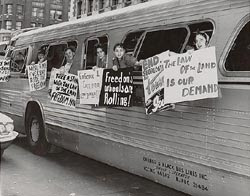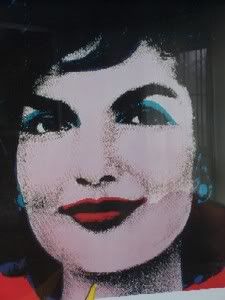Looking back, the Sixties started in the Fifties, although we didn't know it. I was born in 1951. Rosa Parks sat in the bus in 1954, and the Montgomery bus boycott was a full year, from 1954-55.

I can't say I remember it. I should, though. My earliest memory of a newspaper headline is President Eisenhower's heart attack, which, I just learned from a web site, took place in September of 1955. I was sitting on the kitchen floor of our house on 41 Corlies Avenue in Poughkeepsie, and I apparently read it aloud- something like "Ike Comes Home" and this startled my mother. "Who said that?" she demanded, and then looked down at the floor where I sat. "Did you read that?" she asked. I probably replied, smugly, in the affirmative. Why wouldn't I be smug. it was two months before my fourth birthday, and my sister Eileen liked coming home from 2nd grade and passing on the lore of Dick, Jane and Sally.

That Ike headline is the first text I can remember understanding. But I don't remember Rosa Parks or the boycott that followed. I need to check the New York Daily News archives to see if it was even covered. It must have been. After all, the divide in the Sixties was clear - good vs. evil, the non-racist North - that was us- vs the cross-burning bad guys in the South (that was them). (Okay, it was before the race riots in places like Rochester, a city in western NY I never thought I'd ever even visit, let alone live in.)
I do remember Little Rock. It was 1957, and I was 6 years old and starting 2nd grade with Mrs. Wardell, a mean old woman who yelled at us and called us "hooligans." The word itself scared me, and school as a source of conflict was something I could relate to. I noticed Little Rock, and my mother talked about it. I may have even read about it in the Daily News. So the desegregation at Central High School in Little Rock, Arkansas registered with me. These were kids who wanted to go to school. This was pretty confusing to a neurotic 6-year-old. As I said, I was afraid of school. Our teachers yelled at us and even hit us occasionally. My first grade teacher, Miss Cook, had screamed at me for "reading ahead" in Dick, Jane and Sally. Listening to the kids who didn't have older sisters to teach them read aloud was torture. The road ahead to high school looked long and unpleasant (and it was).

But being tormented for being too good at reading, not good enough in math and not rich or popular enough was small potatoes compared to life for black schoolkids under after Brown vs the Board of Education. They were the unwitting footsoldiers who fought the war of desegregation. In 1957, the governor of Arkansas got the state's National Guard to keep the school segregated. President Eisenhower sent in the military to federalize the National Guard.
This is the picture that scared me the most. I imagined what those white people were yelling, and I thought the Negro girl (that was contemporary terminology) had a great dress. I didn't understand the sunglasses, which were worn only by movie stars at the time.

I don't remember when I first saw this 1964 painting by Norman Rockwell which is titled "The Problem We All Live With."

Not only high schools were forcibly integrated. Other people wanted to go to college. James Meredith had to be escorted to campus ("Ole Miss") by US marshals. (I wonder what the they are thinking here.) My mother read James Meredith's story to us from the Readers' Digest over lunch (my brother and I came home every day for sandwiches and Campbell's Soup). She was obsessed with the segregataionists, and I did not understand the history of her outrage until I was much older.

George Wallace, the governor of Alabama, a symbol in the North of the quintessential evil Southerner, did not want educational institutions integrated, as you can see. In 1963, he personally blocked the door the University of Alabama to keep out black students. This became known as the "Stand at the Schoolhouse Door," where Wallace attempted to put into practice his "segregation now, segregation tomorrow, segregation forever" policy from his 1963 inaugural address. He was displaced by Federal marshals.
 It was one of my mother's favorite movies. How could it miss? The elegant and well-spoken Ruby Dee and Sidney Poitier try to get their kids out of the city into a nice Chicago suburban house, only to be unwelcomed by the white neighbors. So it was equal access to education, freedom to live where you wanted to raise your family, and ... the right to VOTE.
It was one of my mother's favorite movies. How could it miss? The elegant and well-spoken Ruby Dee and Sidney Poitier try to get their kids out of the city into a nice Chicago suburban house, only to be unwelcomed by the white neighbors. So it was equal access to education, freedom to live where you wanted to raise your family, and ... the right to VOTE.
I was 10 or 11, and the Freedom Riders' bravery made me feel like a coward. I knew I would never have the courage to facce the evil Southern whites. The Freedom Riders risked their lives to help people register to vote. The people whose names tended to get in the paper were the whites who died. Viola Liuzzo was a mother of five from Detroit who went to Alabama to volunteer in the Civil Rights movement after the March on Selma.

Since I was terrified of all dogs, let alone German shepherds, these images gave me constant nightmares. I'd been raised with my sister's grandmother's horror stories of being chased by Christian boys in Bialystok with their dogs.

Then there were the fire hoses. The water pressure was strong enough to break bones. The hoses and the dogs were used to attack peaceful protesters.


It would be more than forty years before an arrest was made. Two of the mothers of the three, who were 20, 21 and 24 when they were murdered, were alive to see the trial. Dr. Carolyn Goodman, whose husband (Andrew's father) died in 1969, died in 2007.

I felt a connection to this domestic civil war because there was strong support in the Jewish community for black voters' rights. Jewish slavery was not something that happened thousands of years ago in faraway Egypt. We could relate, thanks to the 1961 Eichmann trial, which brought Jewish massacre, slavery and martyrdom to our black and white television every night. Andrew Goodman and Michael Schwerner were Jews from NY. James Chaney was from the south.

It would be more than forty years before an arrest was made. Two of the mothers of the three, who were 20, 21 and 24 when they were murdered, were alive to see the trial. Dr. Carolyn Goodman, whose husband (Andrew's father) died in 1969, died in 2007.

The civil rights battle was fought on all fronts. The South seemed like Nazi Germany, where gays, Socialists, Communists, Jews and other minority groups lost civil rights. The American Negro had been emancipated in 1863, but a hundred years later, could not get a cup of coffee at a Woolworth's lunch counter, or drink from a white water fountain.
No place was spared in the battle, not even the church. It was in the sanctuary of the 16th Street Baptist Church that Addie May Collins, Denise McNair, Carole Robertson and Cynthia Wesley died in the 1963 bombing. This was two months before the murder of President Kennedy and my 12th birthday. I was exactly the same age as the youngest, Denise McNair (top photo).

I don't think about this era every day. When Barack Obama talked about the 106-year-old voter and what she had witnessed in her lifetime, he rattled off a list of indignities and injustices. When he said "bridge in Selma, dogs, firehoses" I was shocked at the black and white images that I recalled, and, well, here they are. So the Civil War is over, as Tom Friendman wrote the other day, and it appears now that yes, we can. After january 20, 2009, two little black girls are going to be running around the White House chasing their new puppy.






2 comments:
You should write for the Times, avenge the household name that was tarnished by their rejection of John's article! no, really - this is good stuff. What a privilege to have lived through it all. This past election is the first thing in my lifetime that I'll say I was proud to have been alive to witness.
I'm with Michelle Obama. Only in America! let's see how long it takes for the Brits to elect a black or Asian PM. Hah. And they are the most likely.
It certainly was a privilege in retrospect, but it felt pretty scary and confusing at the time. There were so many other traumas in the early Sixties - the sad, mysterious death of 36-year-old Marilyn Monroe, beloved comedienne and great American sex symbol, in August, 1962. Then there was the death of Eleanor Roosevelt at 78 a few months later. This was the closest I ever got to President Kennedy, who came to Hyde Park by helicopter for the funeral. A year later, he was dead, at 46. This is why baby boomers are cynical and neurotic and always think the sky is falling.
Post a Comment